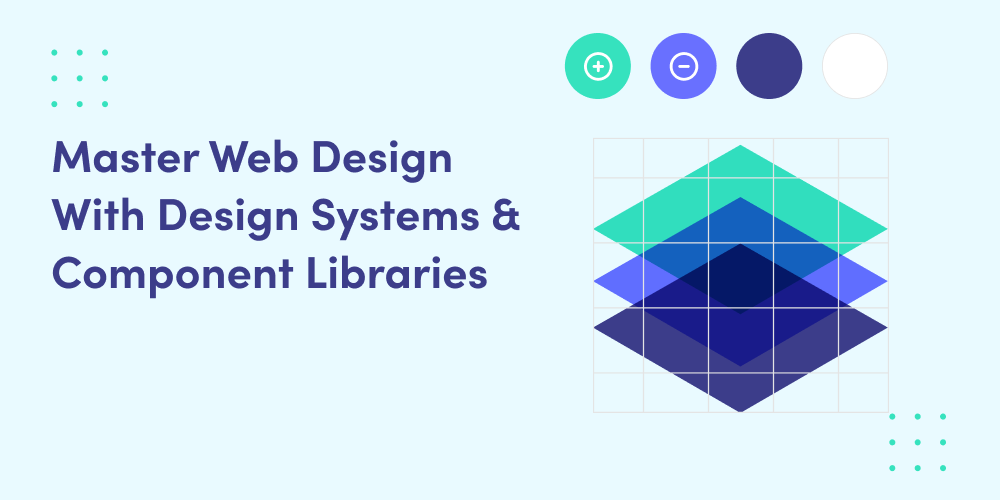In light of the growing demand for consistency and efficiency, tools such as design systems and component libraries have become crucial for developers and designers. There were multiple challenges that website designers in New Jersey faced; they were – inconsistency, lack of collaboration between design and development teams, and lengthy and time-consuming updates. In this blog post, we will discuss about enhancing web design efficiency with proper streamlining of the design process. This will end up resulting in enhanced digital experiences for the user.
Let’s begin!
What are Design Systems and Component Libraries?
Design Systems Defined
A design system is known as a comprehensive set of guidelines and components that function in tandem with each other to create a consistent user experience across multiple applications. Expert designers working at web design companies in NJ follow design systems as a single source of truth. This helps in forming a standardized approach to UI elements and other design components as well.
Component Libraries Unveiled
Under the broader topic of design systems, there exists a concept of component libraries. These libraries consist of pre-designed and pre-coded elements that can be applied to various parts of a web application development project. Components can include simple UI elements such as forms and buttons to more complex ones such as card layouts or navigation bars.
The Benefits of Design Systems
-
Consistency in Design and Branding
If you aim to have a consistent design language and branding across the entire application, adopting a design systems approach is the need of the hour. As there remains a pre-defined set of rules and styles, each team member needs to adhere to them. This makes the design language unified on all parts of the application. Such an approach helps in reducing visual discrepancies and improves brand recognition largely.
2. Efficiency in Development and Maintenance
According to the web design companies in NJ, design systems are known to speed up the development process significantly. The presence of reusable components helps enhance web design efficiency because it saves time for the developer. Developers can use existing components from design systems and not take the burden of finding a new design every time for a page or layout. Also, when it comes to updates or design changes across the website, the design system helps streamline the same. It minimizes the chances of overlooking certain sections of the site (when done manually) and fosters a cohesive user experience for users.
3. Faster Prototyping and Iteration
In order to test and refine ideas fast, rapid prototyping is a prominent feature used in the entire design process. With their inbuilt set of components, design systems enhance the rapid prototyping part of the work. Designers are required to drag and drop elements into the prototype easily with design systems. This, in turn, makes the refinement cycle shorter and enables faster feedback.
Components: The Building Blocks of Design Systems
Understanding Components
Components are referred to as the core building blocks of design systems. They cover certain UI elements and functionalities like input fields, buttons, and navigation menus. The major feature of the component is its reusability factor. Once they are created, they can be reused and applied consistently across the project. This is a major perk in the maintenance process of the application, and it also ensures visual uniformity.
Different Types of Components
Generally, design systems consist of a variety of components, with each serving a specific purpose. Some of the common components include:
Buttons
When button styles are standardized across the application, it ensures a cohesive appearance. This is also available for hover state and disabled state, with various button sizes.
Forms
The form elements are kept consistent with input fields, checkboxes, and radio buttons. The consistency in forms makes the user experience seamless and friendly.
Navigation
Be it a complex navigation bar or a simple menu, when navigation components are defined and reused, it makes the navigation experience better.
Cards and Modals
Cards and Modals are containers for content on the site. The reusable nature of such containers enables a standardized style of presenting information to the user on the platform.
The Importance of Creating and Organizing Components for Reusability
To foster web design efficiency, there should be meticulous attention to the creation and proper organization of components. It is important for the designer and developer to establish a common understanding of every component’s behavior, purpose, and appearance. With proper documentation and categorization, it is ensured that components are easy to discover and reusable, and it brings with it a culture of reusing them across the entire development process.
Conclusion
By now, you must have realized that design systems and component libraries are essential to enable consistency in a development project. In order to enhance web design efficiency, it is of paramount importance that the designer and developer work with a common understanding of the elements and components on the site. In the time to come, the integration of AI will automate the design systems and components part. It will further remove load from the team, and they’ll be left with only ensuring the proper implementation throughout the application.



